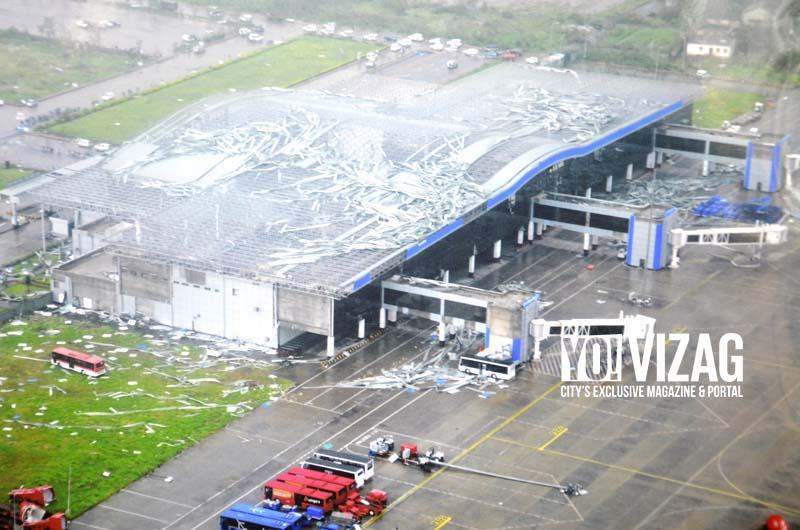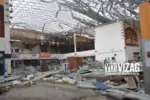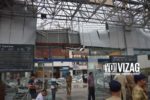We take a look back at the time in 2014 when Visakhapatnam was reeling in the aftermath of Cyclone Hudhud. A throwback, looking at the city that paid dearly in the rendezvous with the brute force of Mother Nature.
N Chandrababu Naidu, Chief Minister of Andhra Pradesh had said, “There is a serious crisis but I also see an opportunity in this situation. I will develop Visakhapatnam into a world-class city from ruins”.
“A vibrant green city next to the verdant blue Bay of Bengal” these were apt words to describe our charming home. But that became passé for a time, thanks to the million-hooded serpent of a cyclone Hudhud that violently gate-crashed the shores of Vizag from inside Bay of Bengal, uninvited, on the dreaded Sunday the 12th October. Now in a throwback to the destruction and devastation of unimaginable magnitude, ‘thanks’ should ‘perforce’ be used.
Brewing trouble – It all started with moderate to strong gales with cloudy sky early in the morning of Sunday. By the time people woke up, electricity was gone, communications were disrupted and strong winds of till-then-unheard-of-or-unseen velocities started engulfing entire areas of our beautiful city. Of course, everybody was aware of the impending cyclone, thanks to the technology, which had predicted its genesis and movement much in advance. Yes, technology could predict the velocity of gales, but it could not be translated into how many roofs would simply fly off. Yes, technology could predict that there would be lull in the middle after it crosses the shore and enters on to the land mass, where people live, but no one could visualise that it would be a lull before a much bigger storm that would prove to be the proverbial salt on the wound inflicted earlier. Yes, technology could predict the pressure in terms of the conventional units of mmHg and SI unit of Pascals, but it could not be translated into how many trees would fall, how many electric poles would fly off, how many cattle would be dead, how many people would become homeless. That it not only faced any resistance to have weakened, but also that favourable situations prevailed in the open seas aided and abetted the intensity and the venom of this cyclonic demon.
A throwback would look at blustery winds coupled with heavy downpours at the speed of as high as 200+ km/h simply ran amok and roughshod over the land destroying everything in its path while moving. The extent of damage that it caused to humans and nature was almost unimaginable. There were scenes that seemed to be straight out of Hollywood disaster thrillers – like brand new cars positioned in the third/fourth floors of a showroom simply rolled and fell to the ground near Muralinagar. Not a single big tree in Vizag Steel Township and Andhra University, probably the greenest areas in entire India, could withstand the fury.
Aftermath – But, the real struggles started the next day after the cyclone HudHud, on Monday morning, the day after the storm. Traffic jams due to road-blocks, power outage, communication disruptions, lack of provisions and all such impediments let loose, and the most dangerous one was that of the health hazard that the stagnated waters posed, especially in low-lying areas, like Convent Junction, Velampeta, One-town, etc.. However, the massive rescue work initiated by state government really brought the situation under control as fast as it could be. The very fact that State’s CM literally stationed himself in Visakhapatnam gave a wonderful boost to the morale of the citizens, in addition to the required fillip to the government machinery that swung into full action. The corrective measures applied after the city was reduced to just rubble and debris were as effective as its preventive measures that it took with the help of National Disaster Management Authority. In fact, the United Nations praised the Government for its effective handling of the situation and conveyed it in unequivocal terms.
Getting back – The administration rose to the occasion and worked with high efficiency levels in cutting trees and clearing way for movement of traffic, or erecting electric poles and repairing connections, or repairing the damaged water and sewerage pipe lines, and so on. The most important aspect to note was the exemplary resolve and spirited work put in by common man in combating this disaster. Everyone chipped in, forming communities in clearing the rubble and debris, or in spreading information about the availability of food and ration using social networking sites, like Facebook, Twitter, etc. or working through NGOs, which pressed into action with full-swing for distribution of food and clothing for the affected people.
With such measures of government, administration, people, communities and NGOs, life had resumed and started coming back to normalcy, of course, with a heavy price. Of course, as they say, the show must go on irrespective of the troubles, tribulations that one faces. Still, it is not out of place to reflect here that the damage could have been mitigated to a greater extent if the correct measures were taken.
Strength – “There is a serious crisis but I also see an opportunity in this situation. I will develop Vizag into a world-class city from ruins. The foundation stone for IT Signature Towers will be laid within a month and work will begin on a fast phase” expressed the Chief Minister, Shri N Chandrababu Naidu. A man who galvanised personnel from all over the State to pitch in and help rebuild Vizag. A man who actually saw to it that the power and telephone connectivity was restored within days rather than weeks or months. A man who had the Government services up and running much before the private providers did. A dynamic CM and the best morale booster Visakhapatnam could ask for.


































































Discussion about this post